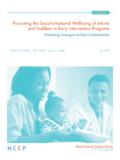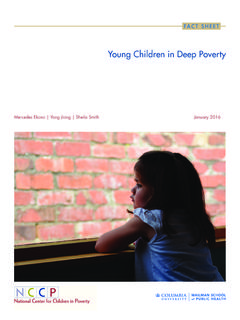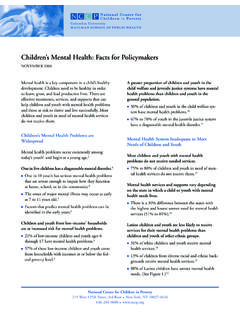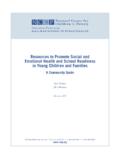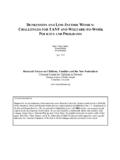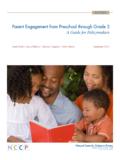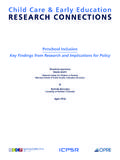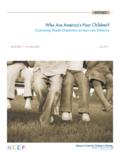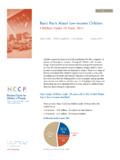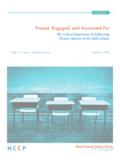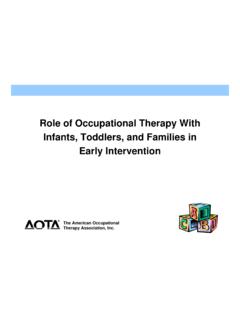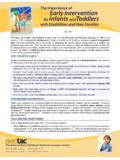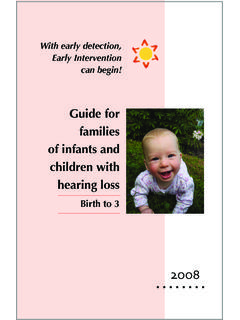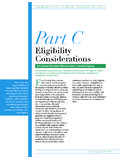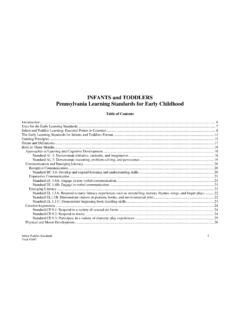Transcription of Helping the Most Vulnerable Infants, Toddlers, and …
1 PATHWAYS TO EARLY SCHOOL SUCCESS ISSUE BRIEF NO. 1 Helping the most Vulnerable Infants, Toddlers, and their FamiliesJane Knitzer Jill Lefkowitz l January 2006 Pathways to Early School Success Issue Brief No. 1 Helping the most Vulnerable Infants, Toddlers, and their Familiesby Jane Knitzer and Jill LefkowitzThis document builds on NCCP s work over the past several years to describe effective programs, highlight policy opportunities, and offer fiscal strategies to promote the emotional health and school success of young children and their families . (See Promoting the Emotional Well-Being of Children and families series, at and also Promoting the Well-Being of Infants, Toddlers, and their families : Innovative Community and State Strategies, at ) These analyses will help policymakers, community leaders, and advocates take action to ensure the healthy development of children and their families .
2 Companion documents focus on fiscal strategies to maximize existing funding streams (Spending Smarter: A Funding Guide for Policymakers and Advocates to Promote Social and Emotional Health and School Readiness) and targeted interventions that can help parents and other early care providers be more effective in promoting healthy relationships and reducing challenging behavior in infants, toddlers, and preschoolers (Resources to Promote Social and Emotional Health and School Readiness in Young Children and families A Community Guide). Many of the specific programs described in this document are more fully detailed in the latter guide. AUTHORSJane Knitzer, , is Executive Director at NCCP and Clinical Professor of Population and Family Health at Columbia University s Mailman School of Public Health.
3 She has contributed many important studies on how public policies can promote the healthy development of low-income children and better support families , particularly those who are most Lefkowitz was a Research Analyst at NCCP where she helped coordinate NCCP projects on Vulnerable children, especially on projects concerning the school readiness of young, low-income authors wish to thank the participants at a meeting on October 22, 2004 who generously and with great wisdom shared insights and experience that shaped this document. We are also grateful to Judith Jerald, Fredericka Bettinger, Elena Cohen, Mimi Graham, and Amy Hunter who reviewed the document.
4 Our thanks go as well to our sister organizations, Zero to Three, and Voices for America s Children, and especially to Tammy Mann, Barbara Welsh, Erica Lurie-Hurvitz, and Susan Kilbourne who participated with us in planning and carrying out the meeting on which the report is based and whose important work continues to inform the field. And, as always, we are grateful to our funders. First, our thanks to Luba Lynch and Joelle-Jude Fontaine of the Mailman Family Foundation who supported this project, but also who have provided leadership to the entire early childhood community in focusing on infants and toddlers. Second, we are grateful to Ruth Mayden and Lisa Kane of the Annie E.
5 Casey Foundation; they understand so clearly how early school success starts with babies and their families . Finally, thanks to Carole Oshinsky at NCCP for her tireless 2006 by the National Center for Children in PovertyThe National Center for Children in Poverty (NCCP) is the nation s leading public policy center dedicated to promoting the economic security, health, and well-being of America s low-income families and children. Founded in 1989 as a division of the Mailman School of Public Health at Columbia University, NCCP is a nonpartisan, public interest research Center for Children in Poverty Helping the most Vulnerable Infants, Toddlers, and their families 3 Table of Contents Executive Summary.
6 5 Introduction .. 10 Setting the Context .. 12 Defining Vulnerability: Empirically-based Approaches .. 13 Risk Indices .. 13 Circumstantial Risk .. 13 Prevalence-based Risks to Effective Parenting .. 14 The Research Rationale for Paying Special Attention to the More Vulnerable Infants, toddler , and families .. 16 Appropriate Goals for Interventions Targeted to the More Vulnerable Infants, Toddlers, and families .. 18 Ten Strategies to Help Infants, Toddlers, and families at Higher Risk for Poor Outcomes .. 19 Strategy 1: Ensure that ALL low-income families have access to infant and toddler child development and family support programs.. 19 Strategy 2: Embed research-informed intensive interventions into Early Head Start and home visiting infant and toddler child development and family support programs.
7 19 Early Head Start Programs as Platforms for Serving families at High Risk .. 20 Home Visiting Programs as Platforms for Serving families at Higher Risk .. 20 Strategy 3: Embed intensive interventions for infants and toddlers and their families in settings serving only high-risk families .. 21 Strategy 4: Organize services by level of family risk.. 23 Strategy 5: Use basic support programs for families to provide more intensive services.. 23 Strategy 6: Build partnerships with early intervention and child welfare systems.. 24 Strategy 7: Screen for and address maternal depression and other risks in health care settings serving women and young children.
8 25 Strategy 8: Implement parenting curricula and informal support groups designed for higher-risk families .. 25 Strategy 9: Build a community approach to prevention and early intervention for groups of babies, toddlers, and families facing special risks.. 26 Strategy 10: Include more Vulnerable families in broader infant , toddler , and early childhood advocacy strategies.. 27 Moving Forward .. 28 Ten Principles to Guide Policy, Practice, and Advocacy .. 29 Conclusion .. 29 Endnotes .. 30 Appendix A: Vulnerable Infants, Toddlers, and families Conference: Participants List .. 33 Appendix B: Contact Information for Resources .. 35 Appendix C: Additional National Resources.
9 374 Helping the most Vulnerable Infants, Toddlers, and their families National Center for Children in PovertyList of BoxesBox 1: Promoting Healthy Relationships and Preventing Problems .. 11 Box 2: Parental and Caregiver Depression and Infants and Toddlers: Selected Short and Longer-term Findings .. 15 Box 3: Research Findings from Court Initiatives for Infants and Toddlers in Miami-Dade County .. 21 Box 4: Excerpts from the infant and toddler Healthy Development Checklist .. 22 National Center for Children in Poverty Helping the most Vulnerable Infants, Toddlers, and their families 5 Executive Summary Compelling evidence from neuroscience about how early relationships and experience influ-ence the architecture of the brain,1 and in turn early school success, has led to increasing pol-icy and practice attention to implementing child development and family support programs like Early Head Start for infants and toddlers.
10 But, there is also a group of babies, toddlers, and parents who face so many risks that pro-grams like these alone may not be enough. This issue brief focuses on the special challenges of Helping babies and toddlers whose earliest experiences, environments, and especially rela-tionships create not a warm and nurturing atmosphere, but what scientists have called toxic stress exposing them to such high and consistent levels of stress that their growing brains cannot integrate their experiences in ways that promote growth and learning. It describes 10 strategies that programs and communities can implement to ensure these babies, toddlers, and families are connected to sufficiently intensive supports that can get them on a path to early school success.
